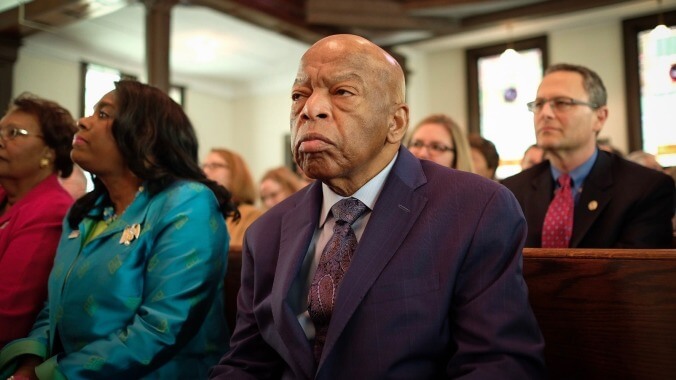John Lewis deserved a more complex tribute to his legacy than Good Trouble


John Lewis’ numerous contributions to the American civil rights movement have garnered him near-universal acclaim and admiration. An activist leader from an early age, he organized sit-ins in Nashville while attending nonviolent workshops run by elder statesmen like Rev. John Lawson. He was one of the original Freedom Riders who protested the federal government’s unwillingness to enforce desegregation laws by riding interstate buses in integrated groups. As chairman of the Student Nonviolent Coordinating Committee (SNCC), he launched the Freedom Summer campaign to register Black voters in Mississippi. Lewis has been arrested countless times for his nonviolent protests, and bears the bruises and scars of violent state-sanctioned oppression, like the ones sustained on Bloody Sunday during the march on Selma. It is no small accomplishment that the last living member of the group who organized the March on Washington has been an active congressman for over 30 years and a major public figure for twice that time.
That everyone, from voters to fellow politicians, loves John Lewis may be the only salient takeaway from the scattered, by-the-numbers documentary John Lewis: Good Trouble. The film’s best scenes are of Lewis in small moments, joking with his staff or engaging with members of the adoring public, where you can plainly see his warmth and compassion. (Lewis’ son jokes that walking through an airport with his father is a tedious affair because he stops and talks to everybody.) A particularly poignant exchange occurs between Lewis and three elderly Black sisters, two of whom remember picking cotton as children. It’s a persuasive reminder that racism in America is neither in the distant past nor erased from living memory, and it works because director Dawn Porter doesn’t overemphasize the significance of the scene.
Unfortunately, these bright spots are smothered by an anecdotal, time-hopping structure that cuts back and forth between the highlights of Lewis’ ’60s activism—told through archival footage with accompanying voice-over or by Lewis directly to camera—and his contemporary work as a congressman. Wedged between these two narratives is another about modern voter suppression efforts in the wake of Shelby County V. Holder, the 2013 Supreme Court decision that struck down key provisions of the Voting Rights Act of 1965. It’s not that these three stories aren’t related but that Porter and editor Jessica Congdon compress them to bare essentials and present them sketchily.
It’s no surprise that Good Trouble, a tribute to a secular saint, incorporates some hagiographic elements, like the litany of prominent liberal politicians who appear on camera to praise him, or the playful validation of his origin stories as modern myth, e.g. a young Lewis preaching to the chickens on his rural Alabama farm, foretelling his future as an orator. What’s stranger is how Porter will sporadically acknowledge criticism of Lewis or cover less flattering periods in his career, then undercut them with affecting footage or good publicity. At one point, Lewis discusses his departure from the SNCC when it moved in the direction of Black Power, something he never chanted because he believes “we all have power.” Following this is footage of Lewis trying to corral cats in his garage. Later, Porter devotes a segment of her film to Lewis’ 1986 congressional campaign, where he played dirty tricks against opponent, fellow activist, and longtime friend Julian Bond. Lewis accused him of using drugs and demanded he follow his lead and take a drug test to sate the public’s curiosity; Bond refused to do so, likening such a request to McCarthyism. Lewis subsequently won the election primarily with the support of white Georgia voters. Porter quickly follows up this section with a montage of Lewis’ electoral accomplishments, with accompanying text detailing how he voted on which bill in what year, scored to Stevie Wonder’s “Higher Ground.”
There’s a defensiveness to such juxtapositions, as if a legacy as strong as Lewis’ couldn’t withstand a critical framework. The fawning approach indicates a general lack of trust in the audience. (This extends to the film’s other questionable formal choices, like the way Tamar-kali’s score crescendos over archival footage of cops rushing a mass of protestors, with hard cuts of police brutality edited to the soundtrack, as if this material required sonic emphasis to convey its power.) At the same time, it’s clear Lewis tightly controls his public and professional persona. This is the version of him he allows us to see.
The result is an uneven paean to a man who deserves a more complicated portrait. Ironically, Good Trouble’s most interesting aspect is its portrayal of the Democratic Party in ideological crisis. Porter draws a telling, likely unintended contrast between freshman Congresswoman Alexandria Ocasio-Cortez, who details in awe how Lewis’ protest work spotlighted the federal government’s inaction at a crucial time of racial upheaval, and U.S. Senator Cory Booker, who recounts the time when he enlisted Lewis to stream a conversation about health care on Facebook Live. It can’t be helped that Good Trouble’s emphasis on mainstream electoral politics is slightly out of step with the grassroots, take-to-the-streets activism of our current moment. Yet it’s commendable that the younger, progressive wing of the party has embraced Lewis’ own definition of civil disobedience that gives this documentary its name.